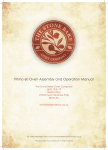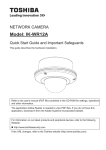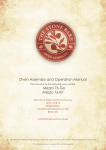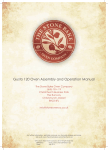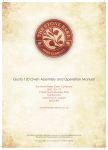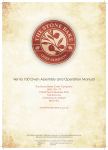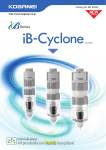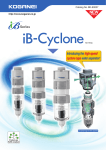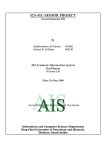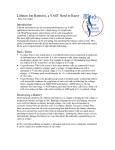Download Primo Render Build Manual - The Stone Bake Oven Company
Transcript
Primo Render Build Manual The Stone Bake Oven Company www.thestonebakeovencompany.co.uk 0845 834 0252 [email protected] © The Stone Bake Oven Company 2014. All rights reserved. Primo 60 Render Build Manual © The Stone Bake Oven Company 2014. All rights reserved. Stage 1 Shuttering boards Excavate ground in chosen position, following the dimensions given in the drawing. Shuttering pegs 150 Place shuttering board into position as shown, using shuttering pegs to stregthan the shuttering board. Once secured, place a waterproof membraine into the shuttering. 1340 1210 min 1450 1320 min Shuttering pegs Shuttering boards Waterproof membrane Stage 2 Half bricks Waterproof membrane Rebar Place 4 half bricks into the shutterd foundations, to suport the rebar mesh. Cut the rebar mesh to size so it fits tightly into the foundations, resting on the half bricks as shown. Once the rebar mesh is in place add your concrete mix, make sure the finished surface of the concrete foundation is levelled. Leave concrete at least 24hrs to set. Waterproof membrane Poured concrete mix Rebar Half brick © The Stone Bake Oven Company 2014. All rights reserved. Stage 3 Once the concrete has fully set, lay your first cousre of dense concrete blocks, following the footprint of the drawing on the right. Once your first block course is in place, using the drawing above as reference, check that the blocks are in the correct position. Continue to add a further three courses of blocks to the first course as shown in the diagram on the left. The blocks will be 4 courses high. 110 min 110 min Stage 4 Now start to lay the outer brick course, following the footprint in the diagram on the right. Again, before proceeding, check that the first brick course is correctly positioned. Add a further 9 courses of bricks untill 10 course brick height has been achieved. Now add the Catnic lintel as shown on in the diagram on the left, this may need to be cut down by an angle grinder. © The Stone Bake Oven Company 2014. All rights reserved. 4 brick courses Stage 5 Lay a further 4 courses of bricks, over the catnic lintel and around the brick perimeter, as shown in the diagram on the left. You may need to use a temporary timber support under the catnic lintel to stop the chances of it flexing before the mortar between the bricks has set. Stage 6 Once the previous 4 brick courses have fully set, measure and cut a piece of 12mm concrete shuttering board, so it tightly fits into the outer brick perimeter. This board will be supported by the dense concrete blocks. If there are any gaps you can use some left over off cuts of waterproof membrane to prevent any concrete seepage. © The Stone Bake Oven Company 2014. All rights reserved. Stage 7 Like the concrete foundations, using 4 half bricks, position towards the corners within the brick parimeter. As shown in the diagram on the left. Cut the rebar mesh so it tightly fits within the brick parimeter, then place onto the 4 half bricks. Add concrete to the shuttered enclosure. Make sure that the concrete hearth is fully levelled. Stage 8 Allow 24hrs for the concrete hearth to fully set. Place the 2 calcium silicate insulation boards onto the concrete hearth, place an equal distance from each side and 200mm from the front of the brick base, as shown below. © The Stone Bake Oven Company 2014. All rights reserved. Stage 9 Place the front oven base segment down onto the calcium silicate insulation board, make sure the oven base is completely centralised and exactly 220mm from the front of the brick base. Once the front base segment is set in postion, place the rear base segment into the front segment, connecting them, ensure that once you have connected the rear segment to the front, that is hasnt been knocked out of postition. Once both segments are in place, measure again making sure they are fully centralised and 220mm from the front of the brick base and 100mm from the back of the brick base. Please refer to the postion diagrams on the opposite page. It is improtant to follow this step accurately, ensuring the following brick courses have room to be laid. © The Stone Bake Oven Company 2014. All rights reserved. © The Stone Bake Oven Company 2014. All rights reserved. Stage 10 Using an angle grinder remove the corners of the oven base as shown in the diagram,try to leave 25mm between the cut and the reccessed oven channel. Place the dome onto the base of the oven, no mortar is needed to bed this although can be used if you require. Using a saw, trim off the excess calcium silicate board as shown in the diagram above. Stage 11 500mm approx. Insert a 45° bend directly into the top of the oven, the flue is quite tight fitting it may take some work to fully insert it. Once the 45° bend is fitted, insert the 330mm length of flue into bend. This will slot into the female element of the bend with no need for adhesive. Once the length is fitted insert the second 45° bend into the female element of the 330mm length. ! PLEASE NOTE: The 45 degree bends and additional lengths are not included in your Primo 60 Kit Oven. It is optional to have the bends in the flue system. A straight 500mm length flue is standard practice and the steps in this manual simply illustrate an alterantive aesthetic finish. If you require additional lengths and angles for the Primo oven, you can purchase them on our online shop or from various online flue specialists. You will need 130mm diameter flue pieces to change the flue configuration of your Primo oven. © The Stone Bake Oven Company 2014. All rights reserved. Stage 12 Innerrick b course Outer rbickcourse Add a course of bricks shown on the left as the inner course, these are added to the sides and front directly inside the outer course. Once the inner course has been laid, add the outer course of bricks, finish by adding bricks to the oven base as below. Ensure a 20mm step is achieved from the inner brick course to the oven base as shown below. No mortarrequi red~200mm Infill ricks b Pre cast rch a Outer rbickcourse Ensure 25mm Fillet seal joiningces fa atrear Stage 13 Once the inner and outer bricks have be laid, you can place a prefabricated archway (included in the Primo 60 Kit oven) into position. You will notice that there is surface space in front of the oven for the arch to sit on. Ensuring the internal contour of the arch is perfectly aligned with the internal oven entrance - in some circumstances, it may be nessesary to bond the archway to the oven face. If so, we recommend using a high head silicone mastic to do so. Use mortar under the feet of the arch if it needs raising slightly. Place some fire cement behind the arch once it is set in place as shown above. 70mm oven base Alternatively, you can create your own custom archway using half bricks and cement to brick around the oven opening. 25mm tile (flush with rth) hea 25mm Calsil board 14th rb ickcourse © The Stone Bake Oven Company 2014. All rights reserved. Ensure 25mm he re t(o a comm odate tile kness) thic (Reduce mortar nt joiifcessa ne ry) Stage 14 Once the arch is set in place, lay your chosen tiles around the oven as shown in the diagram on the left, use suitable outdoor tile adhesive, it does not need to be heat resistant. Next using a tile and concrete drill piece, drill holes to accommodate rawl plugs, every 150mm, then screw in eye screws or hooks to attach the mesh to in the next step. Painting Your Prefabricated Archway Most silicate paints that are suitable for exteriors can be used to paint the prefabricated archway included in your Primo 60 Kit Oven. We recommend the manufacturer data sheets are checked for compatibility prior to using. Drill holes every 150mm -200mm app roximately 50 - 60mm rom oven f w all © The Stone Bake Oven Company 2014. All rights reserved. Stage 15 Once you have laid your tiles of choice loosely place your insulation material around the oven, you are using the insulation not only for insulation purposes but to generate a aesthetic shape. If you have been provided with a box of insulation wool from The Stone Bake Oven Co, you may need to still add additional glass fibre insualtion to generate your chosen shape. Standard glass fibre loft insulation can be used. Once you have loosely laid the insulation around the oven attach chicken wire to the hooks that you earlier drilled into, pull the chicken wire around and form your shape, you can pack insualtion in if your shape is not even, once a satisfactory finish is achieved, tie your chicken wore with cable ties to hold in place. Pull the chicken wire around the flue as shown in the diagram. © The Stone Bake Oven Company 2014. All rights reserved. 150mm approx. Stage 16 Once your chicken wire is safley in place and your desired shaoe is achieved, attach the bottom of a piece of plasters lathe to the hooks earlier inserted, then, as shown on the leftm, with an angle grindermake incisions in the lathe, stopping around 150mm from the bottom of the lathe, this will aloow you to fold the lathe in on itself and mould to your shape. Fold all the lathe in onto your chicken wire and apply with cable ties to hold in place. Do this untill all the lathe is supported. Apply the lathe to the top of the arch, so the render can be applied to the front face of the arch, as shown. You are now ready to render your oven. © The Stone Bake Oven Company 2014. All rights reserved. Stage 17 Apply your render to the mesh, this render can be sand and cement, 4 parts plastering sand, 1 part cement, a glug of PVA. With a trowel apply this to the mesh as shown, until the entire oven is covered. Wait for the render to be 90% set and then wipe it over with a damp sponge in order to work out the trowel lines. Once the render has dried this can be painted with a standard masonry paint to protect it from he elements. © The Stone Bake Oven Company 2014. All rights reserved. Notes © The Stone Bake Oven Company 2014. All rights reserved.
















